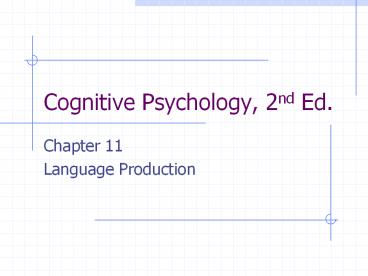Cognitive Psychology, 2nd Ed. - PowerPoint PPT Presentation
Title:
Cognitive Psychology, 2nd Ed.
Description:
Cognitive Psychology, 2nd Ed. Chapter 11 Language Production Speech Production 2-3 words per second with 3-12 dysfluencies per minute, using a vocabulary of 45,000 words. – PowerPoint PPT presentation
Number of Views:122
Avg rating:3.0/5.0
Title: Cognitive Psychology, 2nd Ed.
1
Cognitive Psychology, 2nd Ed.
- Chapter 11
- Language Production
2
Speech Production
- 2-3 words per second with 3-12 dysfluencies per
minute, using a vocabulary of 45,000 words. - Errors can reveal processing units (Easier for a
camel to go through the knee of an ideal).
3
Speech Production
- Agrammatic speech found in the telegraphic
language of Brocas aphasia reveals problems in
grammatical encoding (dogboatuhwater). - Neologisms and pseudogrammatic utterances found
in Wernickes aphasia reveal lexical-semantic
failures (Its a girl uncurl on a boat. A dog is
another dog on a boatum).
4
(No Transcript)
5
Sentence Generation
- Grammatical encoding refers to the selection of
the lexical entries to be used from among those
in the speakers vocabulary and to the assembly of
a syntactic frame. - Phonological encoding referes to the assembly of
sound forms and the intonation to be executed
during articulation.
6
Lexical Representations
- A lemma is an abstract representation of the word
that specifies its semantic and grammatical
features (e.g., goat and sheep share semantic
features and are both nouns but differ in
grammatical gender). - A lexeme is a representation of the phonological
or sound structure of the word (goat and sheep
are totally different at the level of sounds).
7
(No Transcript)
8
(No Transcript)
9
(No Transcript)
10
(No Transcript)
11
(No Transcript)
12
Stages of Grammatical Encoding (She is handing
him some broccoli.)
- Functional processing selects lemmas and assigns
each to a grammatical function or case role.
Example error He is handing her some broccoli. - Positional processing assigns the output to a
phrase structure tree. Example error She was
hand himming some broccoli.
13
Phonological Encoding
- Failures of phonological encoding are common in
the speech of young children (fis is spoken when
fish is needed). - Suprasegmental phonology provides the
- variations in intonation and pauses. Consider
the difference in normal speech and the slow
rate, high pitch, and large intonation changes of
motherese.
14
Articulation
- Phonetics is the study of how speech sounds are
actually produced by the human vocal tract. - Consonants involve constriction of air flow
whereas the mouth is open with vowels allowing
unimpeded phonation.
15
Articulation of English Consonants
- Place refers to the position of air flow
constriction in the mouth (e.g. bilabial). - Manner refers to the way sound is emitted (e.g.,
stops involve complete constriction at the place
of articulation). - Voicing refers to whether the vocal cords
vibrate (voiced) or not. Voice onset time may
differ (baimmediate vs. pa60 ms delay).
16
(No Transcript)
17
(No Transcript)
18
Cascade vs. InteractionGrammatical and
Phonological Encoding
- By phonologically biasing the production system,
people commit Spoonerisms (e.g., saying barn door
instead of darn boor). - Of interest, such errors occur three times more
often for real words (30) than for nonwords
(10), such as saying beal dack instead of deal
back. - The lexical bias effect supports a connectionist
architecture with backward interaction.
19
(No Transcript)
20
(No Transcript)
21
Writing Systems
- Ideographic writing systems date to 10,000 years
ago in Sumeria. - Phonetic writing first appeared 3,500 years ago
in the Sinai desert. A small number of letters
are used to code sounds rather than large numbers
of ideographs.
22
Writing Processes
- Planning refers to retrieving/creating ideas,
organizing ideas, and setting goals. - Reviewing refers to reading the text being
produced and evaluating and editing it. - Translating or generating refers to the
linguistic processes to encode sentences and
links between sentences. Motor transcription is
closely linked in time, just as articulation is
in speech.
23
(No Transcript)
24
Spelling Processes
- Orthography, the mapping of sounds to written
symbols, must be specified only in writing unless
you spell orally. - Dissociation in acquired dysgraphia shows damage
to direct orthographic lexicon to grapheme path.
J.G. could spell nonwords but failed to spell
irregular words (none rather than known.).
Only the phoneme to grapheme conversion path was
intact.
25
(No Transcript)
26
Knowledge-Transforming
- Content problems concern what to say and
rhetorical problems concern how to say it.
Children tell what they want to say about content
but do not reflect on how to say it. - Adults reflect on content and rhetorical problem
spaces concurrently. They may transform
knowledge as a result (i.e., changing what you
think as a result of trying to express your
thoughts). - How do I know what I think until I see what I
say. E. M. Forster
27
Challenges of writing
- Recursive interaction of planning, translating,
and reviewing. - Heavy load on working memory.
- Necessity of maintaining multiple representations
of the authors intent, the actual text produced,
and the readers perspective.
28
(No Transcript)
29
Writers Block
- Writing is easy. All you do is stare at a blank
sheet of paper until drops of blood form on your
forehead. - Gene Fowler
- Inability to produce text caused by evaluation
anxiety, cognitive overload, maladaptive
planning strategies, and other process
dysfunctions.

